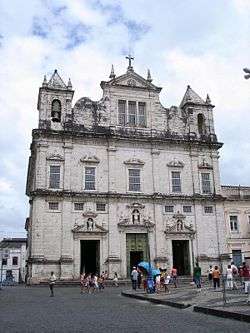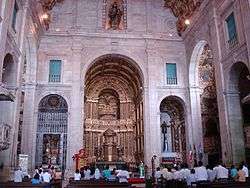Cathedral of Salvador

The Cathedral Basilica of Salvador (Catedral Basílica de Salvador), officially dedicated to the Transfiguration of Christ and named Primatial Cathedral Basilica of the Transfiguration of the Lord is the seat of the Archbishop of the city of Salvador, in the State of Bahia, in Brazil. The Archbishop of Salvador is also ex officio Primate of Brazil.
The Diocese of São Salvador da Bahia de Todos os Santos, the first in the Portuguese colony of Brazil, was created in 1551, only two years after the foundation of Salvador by nobleman Tomé de Sousa. The first bishop, Pero Fernandes Sardinha, arrived in 1552. A cathedral was built in the centre of Salvador around this time.
In 1676 the city became the seat of an archdiocese. After 1758, when the Jesuit Order was expelled from Brazil, the former Jesuit church of Salvador became the cathedral of the city. The building of the former cathedral was demolished in 1933. A scheme of its foundations can be seen on the pavement of the Praça da Sé (Se Square) in Salvador.
Art and architecture
In its origins the present cathedral building was the church of the Jesuit Order of Salvador. The Jesuits arrived in the city still in the 16th century and built a first church and college. In the second half of the 17th century the Jesuits built a new church - the one that exists today - in the Mannerist style then fashionable in Portugal. The façade is very similar to contemporary Portuguese churches like the Jesuit Church of Coimbra.
The façade is made in light Lioz stone brought from Portugal and is flanked by two short bell towers. It has three portals with statues of Jesuit saints, Ignatius of Loyola, Francis Xavier and Francis Borgia. The gable on the upper storey of the façade is flanked by typical Mannerist volutes.

Inside, the cathedral is a one-aisled church of rectangular shape, without transept and with a very shallow main chapel. The side walls of the church have a series of lateral chapels decorated with altarpieces. This floorplan scheme is based on the Church of São Roque in Lisbon, the Jesuit church of the Portuguese capital, built a century earlier.
The chapels of the cathedral offer an interesting showcase of altarpiece art from the late 16th through the mid-18th centuries, all decorated with sculptures and paintings. Very rare are two 16th century Renaissance altarpieces that belonged to the previous Jesuit church and were reused in the new building. The altarpiece of the main chapel is a fine example of 17th century Mannerist art. Other chapels have Baroque altarpieces from the mid-18th century. The barrel vault covering the nave of the church is decorated with wooden panels dating from the 18th century and displays the Jesuit emblem "IHS".
The sacristy of the church is richly decorated with Baroque furniture, 17th-century Portuguese tiles (azulejos) and ceiling wooden panels painted with Mannerist motifs and portraits of important Jesuits.
The façade and floorplan of the Jesuit church of Salvador influenced several other colonial churches in Northeast Brazil, including the São Francisco Church of Salvador.
References
- da Silva Telles, Augusto Carlos: Atlas dos Monumentos Históricos e Artísticos do Brasil. MEC/SEAC/FENAME, 1980.
- The Cathedral of Salvador on the IPHAN site
External links
- Official website of the Salvador Archdiocese
- The Cathedral on the official touristi website of Salvador
Coordinates: 19°35′25″S 42°42′37″W / 19.59028°S 42.71028°W